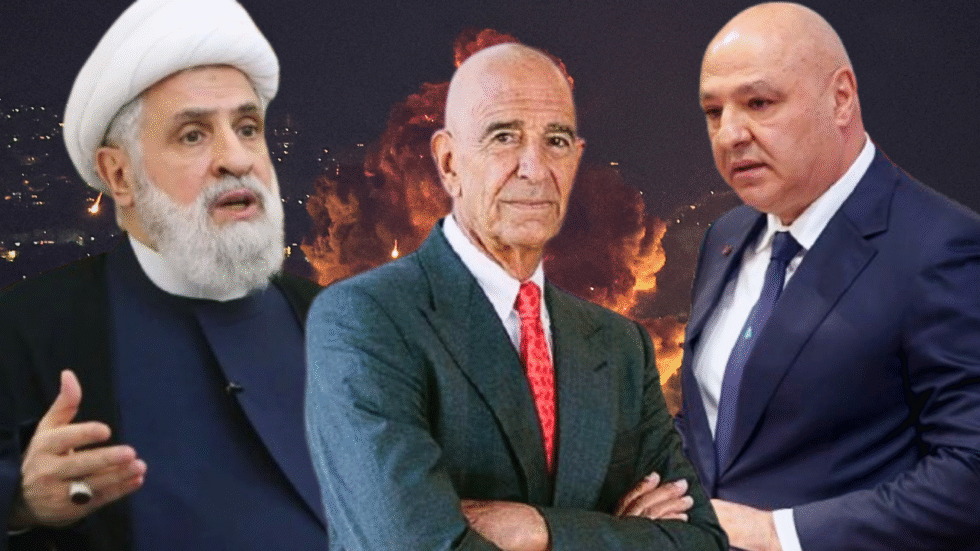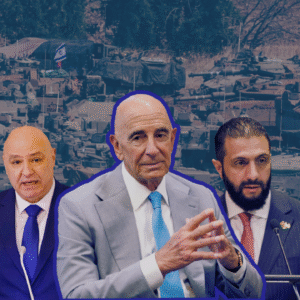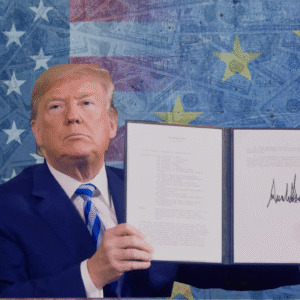Lebanese Cabinet Approves U.S.-backed Plan to Disarm Hezbollah

On Aug. 7, 2025, the Lebanese Cabinet—under President Joseph Aoun’s leadership—took its boldest stand yet, formally endorsing a U.S.-backed plan to restore the state’s monopoly on weapons and disarm Hezbollah.
Yet beneath the surface, the move signals a deeper capitulation to U.S. imperial dictates—one that threatens to reshape Lebanon’s internal balance of power and strip it of its right to resist foreign occupation under the guise of “state sovereignty.”
The “American Paper” and Ceasefire Proposals
The “American Paper,” proposed by U.S. envoy Tom Barrack, was inspired by the 1701 ceasefire agreement following the 2024 war waged on Lebanon by Israel.
The cessation of hostilities entails the disarmament of Hezbollah’s military operations south of the Litani River, in exchange for the complete withdrawal of Israeli troops and a halt to airspace and military aggression.
Once both conditions are met, and with the deployment of the Lebanese Armed Forces (LAF) in the south, the agreement would expand to include the disarmament of all non-state weapons in Lebanon.
However, more than 3,000 Israeli violations have been recorded since the the ceasefire in South Lebanon took effect on Nov. 27, 2025, while Hezbollah has exercised restraint and disarmed in the south, 40 kilometers beyond the border.
Hezbollah Secretary-General Sheikh Naim Qassem stated: “For eight months, Hezbollah and the Resistance have been committed to the government, the army, and the concerned parties, and no violations have been reported regarding their failure to respond to them.”
This policy of strategic patience aims to expose the hypocrisy of the colonial project as Hezbollah recovers from the losses of the past war.
Ongoing Israeli Occupation and Aggression
Israel continues to occupy five strategic points in South Lebanon, despite missing several deadlines for complete withdrawal—the first of which expired on Feb. 18.
Instead, Zionist forces have fortified their military positions through construction activities, including installing monitoring systems and surrounding areas with barbed wire.
Protected by Merkava tanks and U.S. sponsorship, Israel has shown no intention of withdrawing, maintaining its occupation through airstrikes, assassinations, and imperial diplomacy.
These five military sites are not the only targets of Zionist occupation. All villages on the southern border between Lebanon and northern occupied Palestine, including Kfarkela and Shebaa, are frequently subjected to military intimidation—from direct airstrikes to kidnappings of residents.
What Does the Approved Proposal Entail?
MP Gebran Bassil, leader of the Free Patriotic Movement (FPM), now in opposition, said: “Let them at least maintain face! Let them adopt a Lebanese paper, not an American, Syrian, or any other country’s! What a shame!”
In early July, U.S. envoy Tom Barrack proposed to President Aoun a roadmap toward the complete disarmament of Hezbollah by Dec. 31, 2025. In return, the Lebanese president requested U.S. protection against Israeli violations—but performative diplomacy offers little guarantee of a nation’s security.
Barrack stated during meetings with Aoun and Prime Minister Nawaf Salam: “The U.S. has no business in trying to compel Israel to do anything… America could only influence.”
Objectives of Barrack’s Paper Include:
-
Implementing the Taif Agreement, the constitution, and UN Resolution 1701 to extend Lebanese sovereignty over all territories, ensuring weapons are solely in the hands of the state
-
Ensuring the cessation of all hostilities
-
Ending the armed presence of all non-governmental entities, especially Hezbollah, both south and north of the Litani River
-
Deploying the LAF in border areas and internal regions
-
Facilitating Israel’s withdrawal from all territories, including the five points, and resolving prisoner matters through diplomatic means
-
Demarcating international borders between Lebanon and Syria, and Lebanon and “Israel”
-
Convening an economic conference with participation from the U.S., France, Saudi Arabia, Qatar, and other allied nations to support the Lebanese economy and reconstruction
Are the Weapons Legally Legitimate?
To strip the resistance group of its weapons while Israel continues to occupy Lebanese territories—despite several UN calls for its withdrawal—violates Lebanon’s right under international law.
-
UNGA Resolution 37/43 (1982) condemns all acts of “Israeli aggression in the Middle East” and reaffirms the right of all peoples under colonial, foreign, or alien domination to self-determination.
-
Article 51 of the UN Charter states: “Nothing in the present Charter shall impair the inherent right of individual or collective self-defense if an armed attack occurs against a Member of the United Nations…”
-
Additional Protocol I of the Geneva Conventions (1977) acknowledges UN resolutions recognizing the legitimacy of “the struggle of peoples under colonial and alien domination” and states that any attempt to suppress such a struggle threatens international peace and security.
Sheikh Naim Qassem noted: “The Resistance is part of the Taif Accords and is stipulated in the measures taken to protect Lebanon.”
The Taif Agreement, which ended the Lebanese Civil War (1975–1990), required the disarmament of all militias operating in Lebanon, except those involved in liberating Lebanese territories from Israeli occupation.
As Hezbollah has actively resisted Israeli and terrorist aggression, its armed presence has been justified under Lebanese law.
Can the Lebanese Army Protect Lebanon?
“We affirm Lebanon’s right to self-defense in the event of any aggression.” — Nawaf Salam, Aug. 5, 2025
Ideally, a country’s armed forces should serve as its primary defense. However, U.S. imperial pressure has historically prevented the LAF from arming itself to effectively defend Lebanon.
The U.S. views Lebanon as a strategic player in the region in relation to Israel’s expansion in West Asia. Thus, military support is calibrated to keep Lebanon’s forces weaker than Israel’s.
U.S. Restrictions on LAF Capabilities
-
In 2008, Russia offered Lebanon 10 MiG-29 planes, 77 tanks, artillery, and ammunition. Lebanon rejected the offer under U.S. and Gulf pressure.
-
In 2010, Iran offered Lebanon heavy weaponry, mediated by Sayyed Hassan Nasrallah. U.S. pressure again led to its rejection.
Since 2019, Lebanon’s economic crisis has exacerbated the army’s vulnerabilities. Public sector wages have dropped to as low as $80 per month. Lebanon cannot sustain its military without foreign donations.
As a result, the U.S. now monopolizes financial aid to the LAF, with an average of $100 million annually for support and training. Given the Cabinet’s new alignment with U.S. interests, the LAF is unlikely to be able to confront Israel in future conflicts.
A Weak Track Record Against Israeli Aggression
In 2010, an Israel-Lebanon border clash erupted when the IDF attempted to cut trees on the Lebanese side. The LAF responded, killing a senior IDF officer.
The clash also resulted in the deaths of two LAF soldiers and an Al-Akhbar correspondent. Afterward, the U.S. House of Representatives suspended aid to the LAF, prompting condemnation from Lebanon.
Historically, Arab armies have faced consistent defeats in wars with Israel, with the 1973 Yom Kippur War being a rare exception. Guerilla warfare has proven far more effective. Hamas, Hezbollah, and Palestinian Islamic Jihad (PIJ) have achieved strategic victories using these tactics.
-
In 2014, Hamas repelled a seven-week Israeli assault on Gaza.
-
In 2000 and 2006, Hezbollah’s operations led to Israel’s withdrawal from southern Lebanon and prevented the IDF from achieving its goals.
Hezbollah’s tunnel networks and missile capabilities provide defensive advantages that the LAF lacks, especially given its exposure to Israeli airstrikes and intelligence operations.
Why Did Hezbollah Agree to UN Resolution 1701?
Resolution 1701 was first enacted after the 2006 war between Hezbollah and Israel. During that time, the resistance group abided by its terms south of the Litani River. The agreement was reaffirmed after the 2024 war.
Despite abiding by the resolution, Hezbollah retained its arms, as Israel continued to violate the agreement by occupying Lebanese territories and violating its airspace. During that period, Syria—under the Assad government—helped supply Hezbollah with weaponry.
The fall of Assad’s regime in December 2024 led to a new, weaker Syrian government that enabled Israeli expansion and severed Hezbollah’s weapons supply lines. As a result, calls for Hezbollah’s disarmament have grown louder.
In response, Hezbollah declared: “We will deal with the decision… as if it does not exist.”
Similar Patterns
In early July, Tom Barrack told Joseph Aoun: “The region is moving at Mach speed.” He added: “You have Israel on one side, Iran on the other, and now Syria is reemerging strongly and rapidly. If Lebanon doesn’t act, it will return to being part of ‘Bilad al-Sham’ again”—a reference to Greater Syria.
Although Barrack later retracted the statement, it reflected the threat posed by the U.S.-Israeli alliance to Lebanese sovereignty. The demilitarization of states near occupied territories serves the interests of Israel’s colonial ambitions.
This policy is reflected in post-Assad Syria. Netanyahu’s push for the demilitarization of southern Syria has enabled Israel to construct nine new military bases.
Syria has since entered secret normalization talks with Israel, while Lebanese reformists like MP Paula Yacoubian and Christian nationalists such as MP Sami Gemayel have floated the idea of “peace with Israel.”
The Colonial Agenda Behind Disarmament
The U.S.-Israeli agenda is clear: countries that comply with their interests are rewarded with “peace”—a limited, negative peace. Barrack claimed West Asia is rapidly progressing as nations normalize ties with Israel, suggesting that Lebanon’s resistance stance is regressive.
His orientalist language implies that colonized nations must emulate the “civilized” colonizers. But the so-called civilization being promoted is built on the blood of Palestinians—and all who resist Zionist expansion.
In this broader context, the push to disarm Hezbollah is not merely about internal reform—it is part of a wider imperial strategy to neutralize resistance, consolidate U.S.-Israeli dominance in the region, and redefine sovereignty on colonial terms.
If you value our journalism…
TMJ News is committed to remaining an independent, reader-funded news platform. A small donation from our valuable readers like you keeps us running so that we can keep our reporting open to all! We’ve launched a fundraising campaign to raise the $10,000 we need to meet our publishing costs this year, and it’d mean the world to us if you’d make a monthly or one-time donation to help. If you value what we publish and agree that our world needs alternative voices like ours in the media, please give what you can today.














